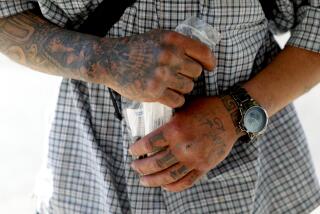2 Boards Join to Stem Illicit Prescription Drug Peddling
- Share via
SACRAMENTO — The State Board of Equalization joined forces with the Board of Pharmacy on Tuesday in a plan to tax pharmacists suspected of selling codeine, Valium and other prescription drugs to street peddlers.
The plan, which state officials say is the first of its kind in the nation, will tax pharmacists up to 40% of the value of suspected drug sales even before the state can prove conclusively that illegal sales are taking place. The stepped up enforcement is to begin immediately.
Officials of the two boards contend that roughly $1-billion worth of prescription drugs find their way onto the streets from pharmacies that commonly report the drugs stolen or missing.
Robert Johnson, executive vice president of the California Pharmacists Assn., said the association is “strongly supportive” of any actions to curb drug trafficking, including the new policy. However, Johnson said, the $1-billion street figure for the drugs is “extremely exaggerated.”
‘Very Limited Activity’
“In our experience,” Johnson said, diverted drug trade “is a very limited activity.”
Officials of the Board of Equalization contend that they already have the legal authority to tax illegal drug profits but have not used it because they have not previously had access to drug sales records that are routinely reported to the Pharmacy Board. Acting alone, the Pharmacy Board could only revoke the pharmacists’ license or close the pharmacy when there was evidence of illicit drug sales.
By joining with the Pharmacy Board, Board of Equalization officials expect to be notified whenever the board receives a report of suspicious purchases by a pharmacy or missing stocks of controlled substances.
“It’s an extension of our existing authority,” said John Meade, spokesman for Conway Collis, a Board of Equalization member.
The plan immediately drew criticism from civil libertarians because pharmacies could be penalized before their involvement in illegal drug sales has been proven in court.
Marjorie C. Swartz, Sacramento lobbyist for the American Civil Liberties Union, said she has no doubt that the Board of Equalization has legal authority to tax what it believes to be illegal drug profits. But she said the new policy raises questions because the accused can be labeled “a criminal without the state proving beyond a reasonable doubt” that they are guilty.
But Swartz said it will take a court challenge to overturn the new taxing policy.
Currently, the Pharmacy Board investigates potential drug-diversion cases after receiving state-required quarterly reports from drug wholesalers and reports of suspicious purchases. The board also investigates tips from individual pharmacists.
Under the cooperation agreement, the Pharmacy Board will notify the Board of Equalization of any suspicions of drug dealings, and the two agencies will simultaneously investigate the reports. If the Board of Equalization determines in its own investigation that the suspicions are founded, it may levy a 25% fraud tax in addition to sales tax and income tax charges, which together could total 40% of the alleged contraband’s value. The Board of Equalization would make an estimate of the drug’s value to determine the amount of tax.
“Now, under this agreement, the Board of Pharmacy and the Board of Equalization will be able to go in together and nail these people who are poisoning our kids and making huge amounts of profits for themselves,” Collis said.
“Drug dealers cost us money and lives. Now we’re going to begin making them pay a price.”
According to Collis, pharmaceutical drugs are commonly diverted through prescription forgeries, robbery, theft and “back door” sales by pharmacy personnel. He noted that much of the problem has been concentrated in the Los Angeles area.
Jay Cavanaugh, an eight-year Pharmacy Board member and president of a drug abuse recovery program, called the agreement “a major new effort . . . between state agencies.”
Cavanaugh said that pharmacists are supportive of the crackdown. “They are responsible, and they are concerned about their reputations,” he said. “In my opinion, they are the best health professionals we have. But a very few people can do a very large amount of damage.”
Both Cavanaugh and Collis agreed that not even 1% of the pharmacies divert drugs but defended the $1-billion figure as accurate. “The public doesn’t realize . . . that there is a major, major problem with the abuse of pharmaceutical drugs,” Cavanaugh said.
Added Collis: “We don’t think we are going to stop the practice, but at least we’re going to begin making them pay a financial price.”
More to Read
Sign up for Essential California
The most important California stories and recommendations in your inbox every morning.
You may occasionally receive promotional content from the Los Angeles Times.










